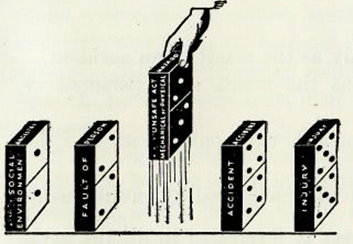Originally posted on September 9, 2022 @ 7:51 AM
Continuing our series on Safety Myths – see them all here
 It seems whenever a safety book wants to identify its roots it traces itself back to Heinrich, Bird, Weaver, Adams, Loftus, Reason and Petersen and the mythical domino construct (The Domino Delusion). Always be suspicious of engineers using myth, metaphor and semiotics to explain their reality because they are expert in none of these.
It seems whenever a safety book wants to identify its roots it traces itself back to Heinrich, Bird, Weaver, Adams, Loftus, Reason and Petersen and the mythical domino construct (The Domino Delusion). Always be suspicious of engineers using myth, metaphor and semiotics to explain their reality because they are expert in none of these.
The domino myth is reinforced and amplified simply by presenting it. This is how all semiotics/myth ‘work’ on the unconscious. Symbols have their own unconscious that validates assertion by appearance and projection. This is how myths create their own reality by attribution and repetition (https://safetyrisk.net/myths-ethics-and-enactment-in-risk/; https://safetyrisk.net/the-risk-matrix-myth/). Myths are not fairy tales but are symbolically powerful at constructing an alternative reality.
Cooper (2001) reinforces and amplifies domino mythology in his book so-called ‘safety culture’. Of course, this is not a book on safety culture. There are so many silences about culture (https://safetyrisk.net/category/safety-culture-silences/ ) in this book (p.6-13) that it leaves more swiss holes so there is no cheese.
It’s a familiar start to any safety discourse to endorse behaviourism by the myth ‘what we do around here’. Whenever you hear this myth, you know the speaker knows little about culture.
This silly myth is the anchor for the BBS myth. All of this is simplistic goop that safety endorses, constructs its own reality (symbolic-myth). But it is not real or true.
Whenever anyone travels back to Heinrich they endorse the behaviourist-engineering roots of BBS.
- https://safetyrisk.net/hoodwinked-by-heinrich/
- https://safetyrisk.net/ration-delusions-and-heinrichs-hoax/
- https://safetyrisk.net/the-heinrich-hoodoo/
- https://safetyrisk.net/heinrichs-propaganda/
- https://safetyrisk.net/the-great-heinrich-hoax/
This is not to say any more than Heinrich was a person of his time; we could expect little more. But to venture back to the 1930s and claim some sense of inspiration or leadership in risk is ludicrous.
Just read the text, myth and semiotics of Heinrich; primitive, behaviourist, linear, binary, simplistic discourse. Of course, he knew of none of the research that was to occur over the next 90 years but when Safety returns to the 1930s as if there is some gem of inspiration, it ignores all we know about risk and Mind over the last 50 years. Heinrich’s domino sequence is a classic example of Heinrich’s myth. And its bad myth that burden’s the safety industry with dangerous nonsense.
There is no domino causality, there is no domino prevention, there is no linear sequence for incidents, there is no ‘self-evident truth’ (1941, p.12). This is all Heinrich goop that enables him to state that accidents are caused by ‘’recklessness, stubbornness, avariciousness, and other undesirable traits of character passed along through inheritance’. (1941, p.13)
Who knew that safety would be spruiking similar nonsense 90 years later as the complacency myth. This is the kind of nonsense that fuels the Justice Cult in safety.
Any sense of Historiography knows that domino theory is nonsense. Life and being is messy, History is messy, the world is random, humans are fallible and, there is no linear causality. Domino theory is essentially a construct and myth that has enabled imperialism, colonialism and brutalism in the name of ‘liberation’. The same for its use in safety.
Domino theory emboldens zero, the myth of predictability and gives the idea that risk can be controlled. It cannot.
Any student of History (https://safetyrisk.net/history-and-safety/) knows that life is chaotic, unpredictable and uncertain. What happens most in safety is that it falls prey to hindsight bias in imposing structure on events that have no structure (https://safetyrisk.net/history-and-hindsight-in-safety/). The denial of radical uncertainty (https://safetyrisk.net/radical-uncertainty/) in safety is a psychosis.
This doesn’t mean that there is no hope in risk but to best tackle risk and safety we need to acknowledge it as a wicked problem . We need to de-mythologize the myths of safety and create positive and constructive, practical ways forward that are closer to reality. We need to ditch the simplistic binary stuff and start moving away from zero so that safety can improve (https://safetyrisk.net/moving-away-from-zero-so-that-safety-improves/).



Andrew Böber says
Good read. You may find the series of posts I wrote on the belief-causality model in relation to this of interest https://waitingway.wordpress.com/2020/04/18/ancestry-and-social-environment-in-causation-part-1/
Rob Long says
Thanks Andrew. I’d rather read a toilet roll packet than read Difford and I find your comments re myth helpful. Of course, the many myths surrounding causality are often generated by engineers who have little cognizance of the language, images, semiotics, metaphors and myths they use to articulate their view on causality. Certainly very few have much of an idea about culture, Socialitie or Mentalitie. Fewer have a clue about Technique (Ellul) and what it does to human persons.